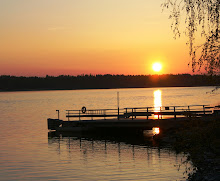Heinäsorsa pesii noin 30 metrin päässä talostamme.
Viimekesänä ihmettelimme, miksi sorsapoikue ilmestyi pellollemme ja tepasteli tyytyväisinä mereen.
Nyt vaikuttaisi, että olisimme lähellä salaisuutta. Sorsa oli viime kesänäkin pesinyt alueellemme ja silloin emme huomanneet pesää.
Nyt se pesä tuli vastaan vahingossa.
Nyt ei voi toivoa kuin parasta, koska taloa ja yleistä tietä melkein yhtä lähellä kuin talo;ei voi siirtää.
Haluaisimme nähdä myös tänä kesänä sorsapoikueen tepastelevan onnellisina mereen
=================================
THE MALLARD´S SECRET
The mallard´s secret
**********************
Sinisorsa eli heinäsorsa (Anas platyrhynchos)The Mallard
Last year I was suprised when duck mother and her ducklins walked to sea.
Now I am near this mysterious. We found without reason abr 30 meter distance from our house the ducks nest.
There are lot of duck´s eggs.
Now for us here is only thing that we can do and support is to hope the best for the duck , so that we could happy with the new duck family again.
*************
(Scourse Wikipedia:)
Breeding behavior
Mallards form pairs only until the female lays eggs, at which time she is left by the male. The clutch is 8–13 eggs, which are incubated for 27–28 days to hatching with 50–60 days to fledging. The ducklings are precocial, and can swim and feed themselves on insects as soon as they hatch, although they stay near the female for protection. Young ducklings are not naturally waterproof and rely on the mother to provide waterproofing. Mallards also have rates of male-male sexual activity that are unusually high for birds. In some cases, as many as 19% of pairs in a Mallard population are male-male homosexual[7].
When they pair off with mating partners, often one or several drakes will end up "left out". This group will sometimes target an isolated female duck — chasing, pestering and pecking at her until she weakens (a phenomenon referred to by researchers as rape flight), at which point each male will take turns copulating with the female. Male Mallards will also occasionally chase other males in the same way. (In one documented case, a male Mallard copulated with another male he was chasing after it had been killed when it flew into a glass window.)[
Rahtilaivat käyttäytyivät merellä oudosti, ja pian taivaalle ilmestyi
drooneja – saksalaisopiskelijat tekivät hurjan löydön
-
Tutkimuksessa löytyi myös useita johtolankoja, jotka yhdistävät sen
kohteena olleita aluksia Venäjän atomienergiayhtiöön Rosatomiin.
41 minuuttia sitten





Ei kommentteja:
Lähetä kommentti